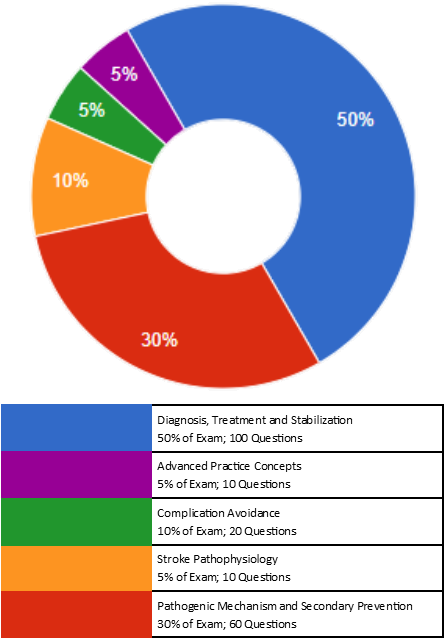ANVP Exam Blueprint
Diagnosis, Treatment and Stabilization
50% of Exam; 100 Questions
- Clinical Localization (20% of Content)
- Neuroimaging Interpretation (20% of Content)
- Reperfusion Treatment for Acute Ischemic Stroke (40% of Content)
- Intra-Arterial Treatment of Ischemic Stroke (10% of Content)
- Medical Management of Hemorrhagic Stroke (10% of Content)
- Intra-Arterial and Surgical Treatment of Hemorrhagic Stroke (5% of Content)
- Airway and Ventilation Management (2.5% of Content)
- Hemodynamic Assessment and Management (2.5% of Content)
Pathogenic Mechanism and Secondary Prevention
30% of Exam; 60 Questions
- Ischemic Stroke Mechanisms by TOAST Classification (15% of Content)
- Transient Ischemic Attack: Diagnosis, Risk, Management (5% of Content)
- Selection of Medical Management (70% of Content)
- Antiplatelet Agents
- Anticoagulation
- Statins
- Antihypertensive Agents
- Smoking Cessation Aids
- Glycemic Control
- Management Decision Making in Extracranial Arterial Disease (10% of Content)
Complication Avoidance
Complication Avoidance in Acute and Sub-Acute Stroke Patients
10% of Exam; 20 Questions
- Venous Thromboembolism (45% of Content)
- Aspiration Pneumonia (40% of Content)
- Mobility and Functional Status (5% of Content)
- Stress Ulcer Prophylaxis (5% of Content)
- Urinary Tract Infection (5% of Content)
Advanced Practice Concepts
5% of Exam; 10 Questions
- Optimizing Emergency Systems of Care (20% of Content)
- Interpretation and Application of Evidence in Clinical Decision Making (40% of Content)
- Outcomes Measurement and Management for Quality Improvement (20% of Content)
- Systems Leadership and Change Management (20% of Content)
Stroke Pathophysiology
5% of Exam; 10 Questions
- Ischemic and Hemorrhagic Subtypes (20% of Content)
- Key Epidemiologic Findings (20% of Content)
- Risk Factor Contribution to Primary Prevention (60% of Content)




